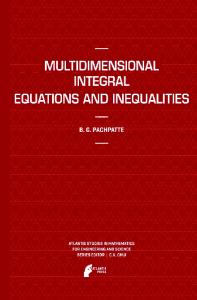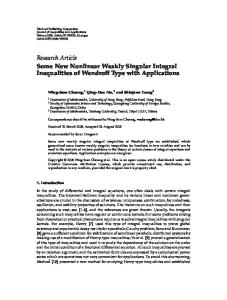Multidimensional Weakly Singular Integral Equations
The final aim of the book is to construct effective discretization methods to solve multidimensional weakly singular integral equations of the second kind on a region of Rn e.g. equations arising in the radiation transfer theory. To this end, the smoothne
- PDF / 9,857,734 Bytes
- 169 Pages / 468 x 684 pts Page_size
- 64 Downloads / 411 Views
1549
Gennadi Vainikko
Multidimensional Weakly Singular Integral Equations
Springer-Verlag Berlin Heidelberg New York London Paris Tokyo Hong Kong Barcelona Budapest
Author Gennadi Vainikko Department of Mathematics University of Tartu EE 2400 Tartu, Estonia
Mathematics Subject Classification (1991): 45-02, 45M05, 45L 10, 65R20, 35Q60 ISBN 3-540-56878-6 Springer-Verlag Berlin Heidelberg New York ISBN 0-387-56878-6 Springer-Verlag New York Berlin Heidelberg
Library of Congress Cataloging-in-Publication Data Vainikko, G. Multidimensional weakly singular integral equations/Gennadi Vainikko. p. cm.(Lecture notes in mathematics; 1549) Includes bibliographical references and index. ISBN 3-540-56878-6 (Berlin: acid-free): ISBN 0-387-56878-6 (New York: acid-free) 1. integral equations-Asymptotic theory. I. Title. II. Series: Lecture notes in mathematics (Springer-Verlag); 1549. QA3.L28 no. 1549 (QA431) 510 S-dc20 (515'.45) 93-14009 CIP This work is subject to copyright. All rights are reserved, whether the whole or part of the material is concerned, specifically the rights of translation, reprinting, re-use of illustrations, recitation, broadcasting, reproduction on microfilms or in any other way, and storage in data banks. Duplication of this publication or parts thereof is permitted only under the provisions of the German Copyright Law of September 9, 1965, in its current version, and permission for use must always be obtained from Springer-Verlag. Violations are liable for prosecution under the German Copyright Law. © Springer-Verlag Berlin Heidelberg 1993 46/3140-543210 Printed on acid-free paper
In memory of Solomon Mikhlin
PREFACE In these lecture notes we deal with the integral equation
uf x) ==
f K(x,y)u(y)dy + f'(x},
x e G,
(0.1)
G
n
where G c IR is an open bounded region or, more generally, an open bounded set (possibly non-connected). The functions f and K are assumed to be smooth but K may have a weak singularity on the diagonal: b==const, \I n-l
21
k =1,2,
Now use (2.14) and a consequence of (2.14): 1j('-j( 21 The result is (2.13'). The proof of Lemma 2.4 is finished.
(2c+1)d G(x ',x 2).
let us present a counter-example showing that (2.13') fails in some cases. let G C 1R 2 be delimited by lines X2 = ± X,2 and x, =1 (see Figure 2.4). Then for x=(X"X 2)EG with O. Recall that lexJI =j. We may use (3.14) with any r>O such that B(x,r)cG, i.e. On
l+llogrl,
lIulio s c'
,
[«] < n-v
l+llogp(x)I, p(x)n-v-/",/ ,
lexl=n-v lexl > n-v
1
1
IlIuli.
The area of Sf x .r) is equal to onrn-1, and with the help of (3.2) we find
I f S(x,r)
S
cr n- 1
[D:-",t K(x,y)]u(y)
dS y
I
1 , V+lexl-1:r}
s c
Is c
Y1
J
Ix-yl-\i p(y)n-\i-1 d y
{yeG: p(y):>:r}
f Ix-yl-\i p(y)-e dy r n-\i-l +1'3
c' p(x)e p(x)n-\i-l
G
where 0 cn-\I
(3.36)
with a fixed 1"0>0 turns to be deciding for the sharpness of Theorem 3.1.
3,10. Sharpnesa of Theorem 3.1 (analysis of model examples). Consider the case n=2 and, for the simplicity, a region GcIR 2 containing the interval (-l,n of the x, axis as a part of ClG (
Data Loading...











